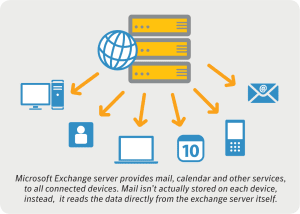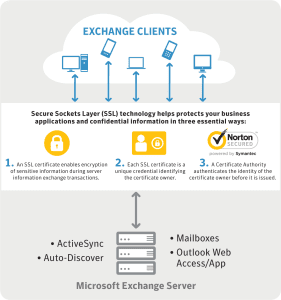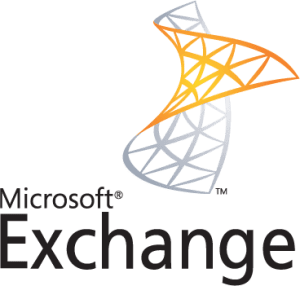Microsoft Exchange: How it fits into business
Microsoft Exchange: How SSL fits into business
applications are essential tools for any business. With the introduction of Microsoft Exchange 2007, 2010 and 2013, businesses are able to leverage constant communication to drive productivity and stay competitive. Along with the new capabilities comes a greater chance of risk that your private and sensitive information being transferred can be compromised. Organizations must be mindful to take the proper security steps to ensure their information is secured and that’s where SSL certificates come in.
There are more perceived risks when shopping online–from information security to pricing and service all of which degrades consumer confidence. If a visitor does not trust your website the sale will be lost.
Why does it need SSL?
-
- ActiveSync: Mobile data synchronizing technology designed by Microsoft. Securing this is important because it relays all information that gets transmitted to wireless devices such as iPads, Cellphones, Tablets and much more.
- Auto-Discover: Carries all kinds of important information that, if compromised, could give an attacker all sorts of access to the network like their usernames and passwords.
- Mailboxes: Emails need to be encrypted to and from the exchange server.
- Outlook Web Access/App: If this is compromised a user would have full access to their email, calendar, and contacts along with other business critical information.
- Outlook Anywhere: Outlook Anywhere allows you to use Outlook to connect to your Exchange server from remote locations without first connecting to the VPN.

Microsoft ExchangeServer: How it fits into business How SSL works within Microsoft Exchange
SSL is used to both authenticate your Exchange server to connecting devices and deliver an encrypted session each time a user connects to your Exchange environment. By using Symantec UCC/SAN SSL Certificates, businesses are able to:
-
- Connect securely to the Exchange Server via a browser using Outlook Web Access/App
- Connect securely to your Exchange Server via Microsoft Outlook using Outlook Anywhere
- Allow Mobile Device users to securely synchronize data, using ActiveSync for Exchange, for sending and receiving email and calendar management
Once your server has been authenticated, a secure SSL connection is established, and encrypted data can be shared between the email or Web client and your Exchange server, ensuring the confidentiality and integrity of all communications.

micro-exchange-client: How it fits into business -
Why Symantec UCC/SAN SSL certificates?
Unified Communication Certificate (UCC) also known as Subject Alternative Name (SAN) functionality offers a cost-effective, versatile option to provide SSL-secured communications for servers using multiple domain names and hostnames—within a single SSL certificate.
- Meets UCC compliance requirements:Recognized by Microsoft for compliance with UCC usagefor Microsoft Exchange and Communications Server.
- Lowers administrative & deployment costs by securing upto 25 separate domains or host names with a single certificate
- Fulfills administration needs of feature-rich environments(e.g., client-server and server-server communications).
- Maximum Protection: Symantec has bothOrganizational Validation (OV) and ExtendedValidation(EV) certificates. Companiesseeking to provide cutting-edge SSLencryption combined with the additionalsecurity and user confidence can use EVcerts to offer maximum protection.
- Offer additional server licensing*
*Symantec SSL Certificate product licensing policy applies: Click Here to View




